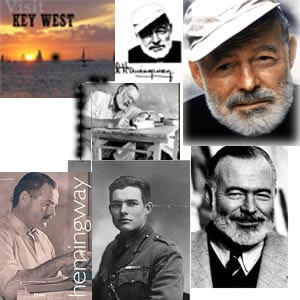
 |
Hemingway |
| HOME |
 |

Ernest Hemingway was born on 21st July 1899 in Oak Park, a suburb of Chicago, Illinois. He was one of six children. His father, Dr Clarence Edmonds Hemingway was a fervent member of the First Congregational church, his mother, Grace Hall, sang in the church choir. At the age of 17 Hemingway published his first literary work. He died aged 61, of self inflicted gun shot wounds. He was one of the most influential of writers of North America. Born 21 July 1899 in Oak Park, he was the second of Clarence Edmonds Hemingway and Grace Hall's six children. His parents wanted him to go to the University of Illinois to study medicine, but it was 1917 and he wanted to join up and fight. He was too young, however, so he started his career as a writer in the Kansas City Star at the age of seventeen. Hemingway was enthusiastic about his work but, after seven months, he volunteered as a Red Cross driver and sailed for Europe in 1918. During his job as an ambulance driver in Italy, he was badly wounded so he returned back to the US in 1919. He was awarded the Italian Silver Medal for Valour for assisting Italian soldiers after he had himself been wounded. He spent considerable time in hospitals. His affair with an American nurse, Agnes von Kurowsky, gave basis for the novel A farewell to arms (1929). The tragic love story and study of an American ambulance officer's disillusionment in the war and his role as a deserter was filmed first time in 1932. After the war, Hemingway worked for a short time as a journalist in Chicago. He moved in 1921 to Paris, where he married the first of his four wives, Hadley Richardson. During this time, he wrote articles for the Toronto Star, and associated with such writers as Gertrude Stein and F. Scott Fitzgerald. In 1922 he went to Greece and Turkey to report on the war between those countries. In 1923 Hemingway made two trips to Spain, on the second to see bullfights at Pamplona's annual festival. During the twenties, Hemingway became a member of the group of outcast Americans in Paris, which he described in his first important work, The sun also rises (1926). In Paris he made himself fluent in French, Spanish and Italian and, in 1923, traveled to Spain. Hemingway used his experiences as a reporter during the civil war in Spain as the background for his most ambitious novel, For Whom the Bell Tolls (1940). Among his later works, the most outstanding is the short novel, The Old Man and the Sea (1952), the story of an old fisherman's journey, his long and lonely struggle with a fish and the sea, and his victory in defeat. Hemingway divorced his wife in 1927 and married Pauline Pfeiffer. They moved to Key West in Florida in 1928, the same year that his father, tormented by illness and financial problems, committed suicide. The novel Farewell to Arms was published in 1929. When Hemingway met journalist Martha Gellhorn she was already interested in the anti-fascist movement in Spain. Having published his influential and passionate book on bull-fighting Death in the Afternoon in 1932, Hemingway was regarded as an expert on things Spanish so, during 1937/8 where he traveled four times to Spain to report on the civil war. He was a spectator of, not a participant in, the Spanish Civil War, but as many writers, he supported the cause of the Loyalist. He met in Madrid Martha Gellhorn, a war correspondent, with whom he had a romance, and who became his third wife. In To whom the bells toll (1940) returned again in Spain. He was nominated for a Pulitzer Prize in 1941, but this was vetoed by right-wing members of the committee. In early 1941 he and Martha Gelhorn reported on the Japanese involvement in China. Unlike his other wives, she went on with her career and Hemingway was often alone. He resented this and drank. Hemingway's drinking had started already when he was a reporter. He tolerated large amounts of alcohol and it did not affect the quality of his writing for a long time. But, in the late 1940s he started to hear voices in his head. When his marriage ended, Hemingway followed in 1944 the allied campaigns in Europe, taking part in the D-Day landings. Against expectations, Hemingway did not keep strictly in his role as an observer. He returned to Cuba in 1946, married Mary Welsh, a correspondent for Time magazine, whom he had met in a London restaurant in 1944. During the Second World War he was a war correspondent for seven months. He seemed to view war as a great outdoor sport, and after the war became boastful and violent. And, in 1954, he won the Nobel Prize for Literature. Hemingway - himself a great sportsman - liked to portray soldiers, hunters, bullfighters - tough, at times primitive people whose courage and honesty are set against the brutal ways of modern society, and who in this confrontation lose hope and faith. His straightforward prose, his spare dialogue, and his predilection for understatement are particularly effective in his short stories, some of which are collected in Men Without Women (1927) and The Fifth Column And The First Forty-Nine Stories (1938). During 1960-61, he disintegrated physically. He had high blood pressure, diabetes, kidney and liver disease. The drugs he was put on had the side effect of making him depressed. He was taken into the Mayo Clinic where he was treated with electric shock treatment that exacerbated his mental illness. On release from hospital in July 2, 1961, he committed suicide by shooting himself with his favorite shotgun in the head one morning in the hallway of his home in Ketchum, Idaho. |
|
|